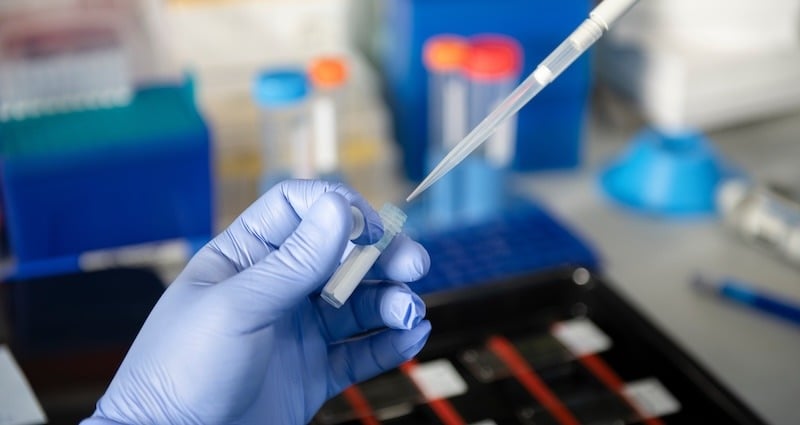
A norovirus test scans for one of the most common and highly contagious causes of gastroenteritis, affecting millions of people each year. While Norovirus is often associated with cruise ships, it’s quite common to have norovirus outbreaks that originate in restaurants, schools, healthcare facilities, and other crowded environments.
Since norovirus can spread rapidly through contaminated food, water, surfaces, and direct contact, early detection and proper testing are critical in controlling outbreaks.
This guide will cover when and how to test for norovirus, the best testing methods, and preventive measures to keep your environment safe.
What is Norovirus?
Norovirus is a highly contagious virus that causes acute gastroenteritis, leading to sudden onset vomiting, diarrhea, stomach cramps, and nausea. Often referred to as the "stomach flu" (though it's not related to influenza), norovirus is the leading cause of foodborne illness in the United States. It spreads quickly through contaminated food, water, surfaces, and direct person-to-person contact, making it a major concern in restaurants, schools, hospitals, nursing homes, and cruise ships.
Common Norovirus Symptoms
Symptoms of norovirus infection include:
-
Nausea
-
Vomiting
-
Diarrhea
-
Stomach cramps
-
Fever
Please note that many of these symptoms overlap with other illnesses, so you should talk to a healthcare professional if you are experiencing any of these issues.
How Common is Norovirus?
Each year, norovirus causes an estimated 21 million illnesses in the U.S. alone, leading to 2,500 reported outbreaks. While the virus circulates year-round, outbreaks are most frequent between November and April. Food service workers are a major source of transmission, with about 50% of all foodborne outbreaks in the U.S. linked to norovirus contamination.
How Long Does Norovirus Last?
Most people recover from norovirus within one to three days, but the virus remains contagious for up to two weeks after symptoms disappear. Because norovirus is resistant to many disinfectants and can survive on surfaces for weeks, outbreaks can be difficult to control without proper hygiene and sanitation practices.
Where Do Norovirus Outbreaks Happen?
Norovirus thrives in crowded, high-touch environments, including:
-
Healthcare facilities: Over 50% of U.S. norovirus outbreaks occur in hospitals and long-term care facilities, where infections can be more severe in elderly or immunocompromised patients.
-
Schools and childcare facilities: Close quarters and shared spaces make schools a common site for outbreaks, sometimes leading to campus closures.
-
Food service and restaurant establishments: Infected food workers can spread norovirus by handling food improperly, especially raw produce, shellfish, and ready-to-eat items.
-
Cruise ships and travel hubs: The close living quarters and shared dining areas on cruise ships make them particularly vulnerable to norovirus outbreaks.
Because of its rapid transmission and ability to linger on surfaces, early detection and proper testing are essential in stopping norovirus outbreaks before they spread further.
How to Prevent a Norovirus Outbreak
While outbreaks are disruptive, prevention is the best defense. Simple protocols can help minimize risk, especially in food service and healthcare environments. Those best practices include:
-
Strict sick leave policies: Food handlers and staff should not return to work until 72 hours after symptoms stop.
-
Frequent hand washing: Proper hand hygiene is the most effective way to prevent norovirus spread.
-
Protective cleaning gear: Staff should use gloves, masks, and disposable aprons when cleaning up after symptomatic individuals.
-
Isolate infected individuals: In residential settings, keep symptomatic people separate from others.
-
Reduce contact during outbreaks: Limit group gatherings and unnecessary staff interactions.
-
Regular environmental testing: To prevent the spread of the virus, conduct regular environmental testing (using the swabs below) in high-risk areas.
Which leads us to…
When to Initiate a Norovirus Test
Since it’s hard to tell whether norovirus is present before symptoms arise, the best time to test for norovirus is as soon as an outbreak is suspected. If multiple individuals within a facility—such as a school, hospital, or restaurant—begin showing symptoms, immediate testing is recommended.
Testing early helps to confirm contamination, allowing facilities to take swift action to disinfect and implement outbreak controls. Or, even better, stay ahead of the curve and add periodical Norovirus surface testing to your sanitation protocol.
Where to Perform a Norovirus Test - High Vigilance Environments
Norovirus is incredibly resilient, surviving on surfaces for weeks and resisting many common cleaning products. Because of this, testing should focus on areas that are frequently touched and those exposed to bodily fluids.
High-Risk Areas for Norovirus Contamination
-
Restroom surfaces: Toilets, sinks, faucets, and door handles
-
Food prep areas: Counters, coolers, ice machines, cutting boards and trash receptacles
-
High-touch surfaces: Doorknobs, elevator buttons, tables, and phones
-
Workstations of sick employees: Any area used by symptomatic staff
-
Incident locations: Areas where an infected person vomited or had diarrhea
Testing these surfaces can help identify the presence of norovirus and confirm the need for targeted cleaning and preventive measures.
How to Conduct a Norovirus Test
Proper specimen collection is essential for accurate testing. Follow these best practices when collecting norovirus surface samples:
Step 1: Wear protective clothing
Use sterile gloves and single-use attire to avoid cross-contamination.
Step 2: Swab strategically
Move from cleaner areas to dirtier areas, using a fresh swab for each zone.
Step 3: Use a multi-directional swabbing technique
Swipe surfaces using horizontal, vertical, and diagonal strokes.
Step 4: Limit sample area
Swab a 700 cm² surface or smaller to concentrate sample collection.
Step 5: Secure and label samples
Place swabs in sterile transport tubes and label them clearly.
Step 6: Transport samples quickly
Store in an insulated cooler and send to a laboratory within 24-48 hours.
Want more assistance? Check out this step-by-step guide on norovirus testing.
Recommended Supplies to Have On Hand for a Norovirus Test
Puritan has over 100 years of experience developing swabs specifically designed for various testing needs – this includes norovirus testing. Our foam-tipped environmental sampling swabs provide excellent sample collection and transport reliability.
Top Norovirus Test Swabs
Designed for surface sampling, these sterile collection-sampling kits are used for the detection of human norovirus on environmental surfaces. They are a reliable tool when used to test for contamination during outbreaks.
EnviroMax 6" Sterile Pointed Foam Sampling Swab & Dry Collection Tube
SKU#: 25-88010 PFB UW
EnviroMax Plus 6" Sterile Pre-Moistened Pointed Foam Swab & Collection Tube
SKU#: 25-88050 PFB UW
These sterile collection kits are for detecting norovirus on environmental surfaces, helping health professionals and facility managers identify contamination quickly and accurately.
How to Clean and Disinfect After a Norovirus Outbreak
Once norovirus has been detected, cleaning protocols must be rigorous and immediate to prevent further spread. Not all disinfectants are effective against norovirus, so it’s critical to use the right cleaning agents and methods.
Best Practices for Norovirus Disinfection Post Norovirus Test
-
Clean first, disinfect second: Remove visible contaminants before applying disinfectants.
-
Deep clean high-risk areas: Bathrooms, kitchens, and frequently touched surfaces require extra attention.
-
Use EPA-Approved disinfectants: Chlorine bleach (at 1000–5000 ppm concentration) is the most effective.
-
Avoid quaternary ammonium compounds: These are ineffective against norovirus.
-
Allow proper contact time: Let disinfectants sit on surfaces for at least 5 minutes before wiping.
Case Study: How Puritan Helped Develop a Better Norovirus Test and Detection Solution
Norovirus detection has historically been challenging, with limited reliable testing options for environmental surfaces. Puritan developed a foam-tipped swab specifically designed for collecting norovirus samples from hard surfaces, ensuring effective specimen collection. To enhance usability, a long-handle swab was created to easily reach contaminated areas while still fitting transport tubes for secure handling.
Additionally, a pre-moistened swab option was introduced to improve sample uptake and transport reliability. These swabs have been rigorously tested in real-world environments, including restaurants, hospitals, and daycares, to ensure their effectiveness in detecting norovirus contamination.
Today, public health teams, food safety professionals, and environmental scientists use Puritan’s EnviroMax® and EnviroMax Plus® swabs to detect norovirus and stop outbreaks before they spread.
Putting Puritan Swabs to the Test in a Nashville Daycare Center
As part of a real-world evaluation, Puritan’s environmental sampling swabs were tested in a Nashville daycare center, where high-touch surfaces can easily become contamination points. Under the guidance of Environmental Health Specialist D.J. Irving, Puritan team member Ginny Templet collected samples using specially pre-moistened foam-tipped swabs.
Samples were collected from
-
Door knobs
-
Toilet seats
-
Changing tables
-
Hand basins
-
Chairs
-
Toys
Each sample was meticulously documented to track collection sites before being transported to a laboratory for processing. A lab technician then extracted the specimens and carefully prepared them for DNA analysis, a process that took an entire afternoon to complete.
A few days later, the results were in: no pathogens were detected in this exercise. While this particular daycare center was given the all-clear, the study reinforced the effectiveness of Puritan’s swabs in environmental pathogen detection and highlighted their role in preventing norovirus outbreaks before they start.
Staying Ahead with Norovirus Test Supplies On Hand
Norovirus outbreaks can cause significant health risks, lost revenue, and reputational damage for businesses and institutions. Early detection, proper testing, and rigorous cleaning protocols are critical to managing outbreaks and protecting public health.
By using Puritan’s industry-leading environmental sampling swabs, facilities can confidently test for norovirus, ensuring safer environments for employees, customers, and residents. Ready to stock up on EnviroMax for your facility? Get in touch with our sales representatives for assistance. We’re here to help.




